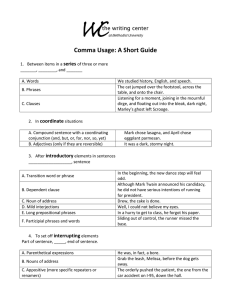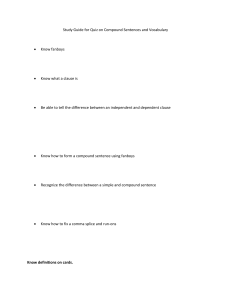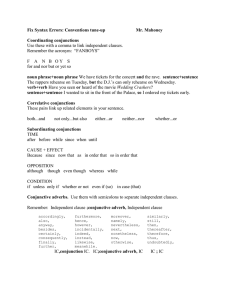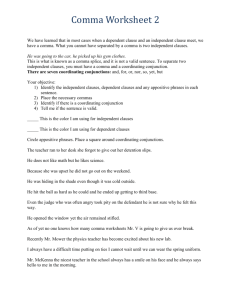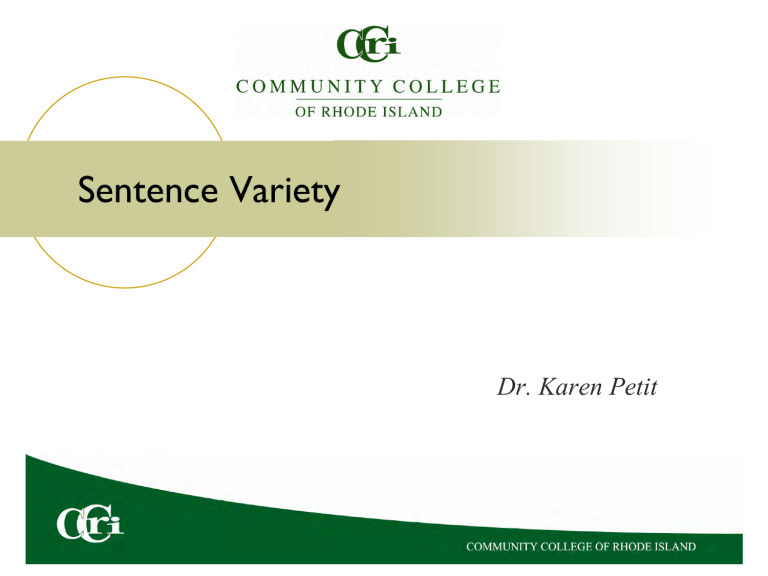
Sentence Variety Dr. Karen Petit Unvaried Sentences Unvaried sentence structures make ideas sound simplistic and repetitious: The pencil was yellow. The pencil was new. The pencil was rolling off the table. I picked up the pencil. Varied Sentences Varied sentence structures sound better because they are connecting ideas together into more interesting, creative, logical, and professional structures: A new yellow pencil, which I quickly picked up, was no longer able to roll off the table. I picked up the new yellow pencil before it could roll off the table. How Do You Want People to React to Your Writing? Readers dislike unvaried sentences. Without variety, writing is boring, uncreative, illogical, and simplistic. Readers like varied sentences. With variety, writing is interesting, creative, logical, and professional. Structures for Varied Sentences Prepositional and verbal phrases Conjunctive adverbs and transitional phrases Coordinating conjunctions Correlative conjunctive pairs Subordinating conjunctions Relative pronouns Prepositional Phrases A Prepositional Phrase = a preposition + sometimes one or more adjectives + a noun or a pronoun Prepositions include: about, across, after, among, as, at, before, behind, beside, besides, between, by, during, except, for, from, in, inside, of, on, onto, outside, over, than, through, toward, under, until, upon, with, without A comma will usually follow an introductory prepositional phrase: Near the computer, the desk was visible. A comma is generally not used for phrases at the end of a sentence: The desk was visible near the computer. Verbal Phrases A Verbal Phrase = a present participle, a past participle, or an infinitive verb form + modifying words A comma will usually follow an introductory verbal phrase: Walking up the hill, the students quickly arrived at the front door. Commas often are not used after a phrase at the beginning of a sentence that has a subject following the verb: Walking down the hill were the college’s graduating students. A comma is usually not used with phrases at the end of a sentence: The students arrived early by walking up the hill. Conjunctive Adverbs and Transitional Phrases Conjunctive adverbs and transitional phrases can be placed between two independent clauses or within a clause. The punctuation depends on where the adverb or the phrase is placed. Here is a joining word between two independent clauses: People like to write their essays on computers; then, the essays can be more easily revised. consequently finally for example however in fact moreover on the other hand then therefore thus . . . Here is a joining word between the subject and verb of the second clause: People like to write their essays on computers; the essays, then, can be more easily revised. Coordinating Conjunctions can be joined by using one of the coordinating conjunctions (the fanboys). for and nor but or yet so Two clauses joined with one of the FANBOYS will have a comma: Writing can be fun, but many people call it hard work. Punctuation of FANBOYS with Words/Phrases or Clauses Punctuation for coordinating conjunctions (fanboys) is different for words/phrases and clauses. Two words or phrases joined with one of the FANBOYS will have no commas: Writing can be a fun activity and hard work. Three words or phrases joined with one of the FANBOYS will have commas: Writing can be fun, exciting, and interesting. Two clauses joined with one of the FANBOYS will have a comma: Writing can be fun, and it can also be hard work. Correlative Conjunctive Pairs can be joined by using correlative conjunctive pairs. both___and___ either___or___ neither___nor___ whether___or___ not only___but___ not only___but also___ Correlative conjunctive pairs join together parallel items: Both the computer and the pencil were on the table. Whether the computer was new or the computer was old, we still loved using it. Subordinating Conjunctions Subordinating conjunction + after although as as if because before even even though if since though unless until what when where while . . . A subordinate clause can be placed at the beginning, middle, or ending of a sentence. Because writers love communication activities, they also love to read. Writers, because they love communication activities, also love to read. Writers also love to read because they love communication activities. Punctuation with Subordinating Conjunctions When a subordinate clause is at the end of a sentence, most of the time, there is no punctuation. People like to read poetry out loud because the sounds will be more noticeable. When the subordinate clause is at the beginning of the sentence, then a comma is needed to separate the two clauses from each other. Because the sounds will be more noticeable, people like to read poetry out loud. Relative Pronouns Relative pronoun + who whoever whom whomever which that A subordinate clause that begins with a relative pronoun can be put into different places in a sentence: Anyone who likes to write should also like to read. One of my ancestors met Shakespeare, who was a great writer. Punctuation with Relative Pronouns A relative pronoun “relates” an idea in a clause to the noun or pronoun that immediately precedes it. If the relative pronoun and the rest of its subordinate clause restrict the meaning of the preceding noun or pronoun, then no comma is used: Anyone who likes to write should also like to read. If there is no restriction, then the items must be separated by commas: One of my ancestors met Shakespeare, who was a great writer. Emily Dickinson, who was also a great writer, wrote that poem. More Information The Writing Center at the Community College of Rhode Island has more online resources. Contact Information This presentation is the creation of Dr. Karen Petit Community College of Rhode Island 400 East Avenue Warwick, RI 02886 E-mail: kmpetit@ccri.edu Phone: 401-825-2279

